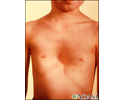Noonan syndrome
Noonan syndrome is a disease present from birth (congenital) that causes many parts of the body to develop abnormally. In about 50% of cases, it is passed down through families (inherited).
Noonan syndrome is linked to variants in several genes. In general, certain proteins involved in growth and development become overactive as a result of these gene changes.
Noonan syndrome is an autosomal dominant condition. This means only one parent has to pass down the variant gene for the child to have the syndrome. However, some cases may not be inherited and instead happen by chance (spontaneously).
Symptoms
Symptoms include:
- Delayed puberty
- Down-slanting or widely-spaced eyes
- Hearing loss (varies)
- Low-set or abnormally shaped ears
- Mild intellectual disability (only in about 25% of cases)
- Sagging eyelids (ptosis)
- Short stature
- Small penis
- Undescended testicles
- Unusual chest shape (most often a sunken chest called pectus excavatum)
- Webbed and short-appearing neck
Exams and Tests
Your health care provider will perform a physical exam. This may show signs of heart problems the infant had from birth. These may include pulmonary stenosis and atrial septal defect.
Tests depend on the symptoms, but may include:
- Platelet count
- Blood clotting factor test
- ECG, chest x-ray, or echocardiogram (ECHO)
- Hearing tests
- Growth hormone levels
- Renal ultrasound
Genetic testing can help diagnose this syndrome.
Treatment
There is no specific treatment. Your provider will suggest treatment to relieve or manage symptoms. Growth hormone has been used successfully to treat short height in some people with Noonan syndrome.
Support Groups
More information and support for people with Noonan syndrome and their families can be found at -- www.teamnoonan.org, and www.rasopathiesnet.org.
Possible Complications
Complications may include:
- Abnormal bleeding or bruising
- Buildup of fluid in tissues of body (lymphedema, cystic hygroma)
- Failure to thrive in infants
- Leukemia and other cancers
- Low self-esteem
- Infertility in males if both testes are undescended
- Problems with the structure and function of the heart
- Short height
- Social problems due to physical symptoms
When to Contact a Medical Professional
This condition may be found during early infant exams. A geneticist is often needed to diagnose Noonan syndrome.
Prevention
Couples with a personal or family history of Noonan syndrome may want to consider genetic counseling before having children.
References
Cooke DW, Divall SA, Radovick S. Normal and aberrant growth in children. In: Melmed S, Auchus RJ, Goldfine AB, Koenig RJ, Rosen CJ, eds. Williams Textbook of Endocrinology. 14th ed. Philadelphia, PA: Elsevier; 2020:chap 25.
Madan-Khetarpal S, Arnold G, Ortiz D. Genetic disorders and dysmorphic conditions. In: Zitelli BJ, McIntire SC, Nowalk AJ, Garrison J, eds. Zitelli and Davis' Atlas of Pediatric Physical Diagnosis. 8th ed. Philadelphia, PA: Elsevier; 2023:chap 1.
Mitchell AL. Congenital anomalies. In: Martin RJ, Fanaroff AA, Walsh MC, eds. Fanaroff and Martin's Neonatal-Perinatal Medicine. 12th ed. Philadelphia, PA: Elsevier; 2025:chap 29.
Review Date: 3/31/2024
Reviewed By: Anna C. Edens Hurst, MD, MS, Associate Professor in Medical Genetics, The University of Alabama at Birmingham, Birmingham, AL. Review provided by VeriMed Healthcare Network. Also reviewed by David C. Dugdale, MD, Medical Director, Brenda Conaway, Editorial Director, and the A.D.A.M. Editorial team.













